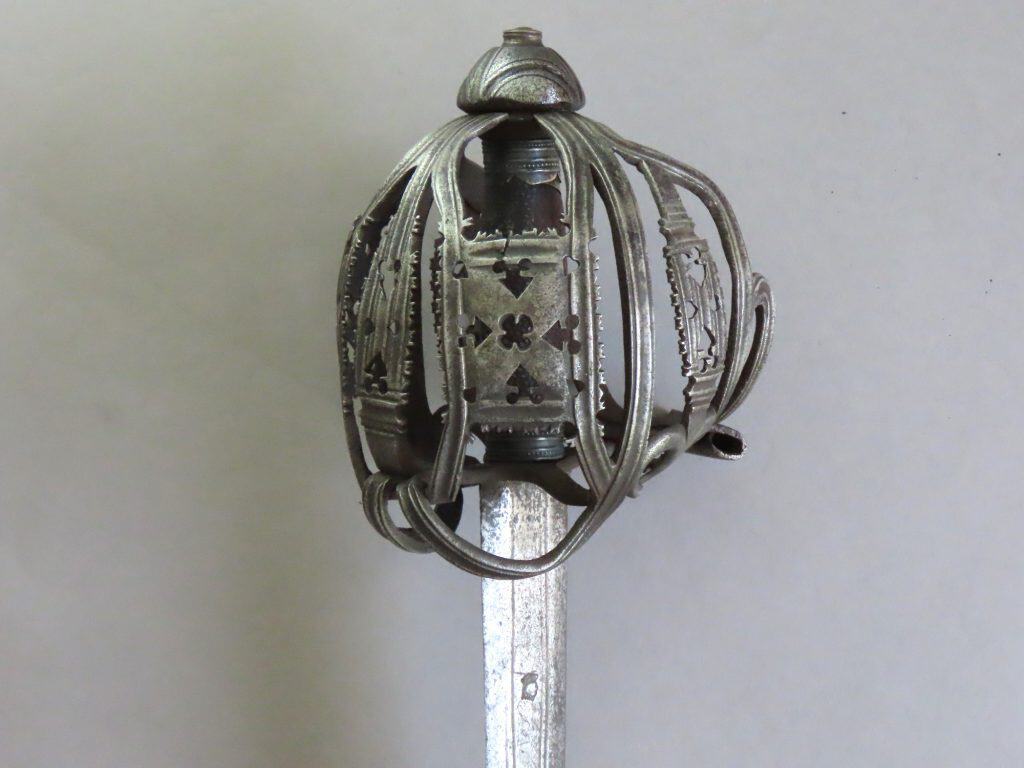
A Scottish Basket Hilted Sword of “Glasgow Style” dating to the early 18th century probably from the workshop of Thomas Gemmill
To enquire about this itemplease click here
Price: £7,450
Ref: AA.073.23
Item Description
An imposing and well balanced sword of fine quality workmanship which represents the highest standard of the Scottish sword making craft during the years surrounding the Jacobite Rebellion of 1715. The sword is mounted with a broad double edged blade. The main structural bars of the guard are of thick flattened rectangular section. These are decorated on the outside with incised longitudinal grooves along the middle, with a narrower groove on each side, in what has come to be known as the “Glasgow Style”.
The style of decoration was developed by sword makers in Glasgow towards the end of the 17th century and continued until the third quarter of the 18th century. The style was copied by the most skilled smiths in other sword making centres in Scotland and was also adopted for the British military by the Birmingham based Ordnance manufacturers such as Harvey in the mid-18th century.
The Glasgow style of hilt decoration is distinctive. Filing and incising the bars in this manner is a time consuming and skilled task demanding many hours of work and reserved only for the best and most expensive hilts. The pommel has a ribbed button on top from which three sets of triple grooves radiate to the pommel edge identical in form to those which decorate the main guard bars. Further decoration in the same manner formed as crescents decorate the spaces between. The guard arm terminals tuck securely into a groove cut around the lower part of the pommel.
One of the most significant makers of basket hilted swords based in Glasgow was Thomas Gemmill. Few examples of his work survive. He was active in the early part of the 18th century and became Kings Armourer in 1718. This hilt is not initialed by a maker but there are features which indicate it was made by Gemmill probably before he became Kings Armourer after which most of his work was most likely stamped. For similar swords by Thomas Gemmill see Cyril Mazansky, “British Basket-Hilted Swords”, Boydell Press, 2005, pages 117 Ref: F16b (TG) and 119 Ref: F16d (TG).
The basket hilt of our sword has been intentionally forged to appear slightly asymmetrical when viewed from the front with the basket appearing slightly swollen to the right compared to the left. This is another mark of quality indicating that the hilt was made for a right hand user. The swollen side of the hilt accommodates the fingers of the right hand whereas the opposite side needs only to accommodate the thumb which takes up less space inside the hilt. The grip is formed with a spirally grooved wooden core covered with shagreen and bound with silver wire. Ribbed silver ferrules are also mounted onto the grip top and bottom.
The tapering lenticular section blade is a fine late 17th century example of a type popular with Scots. It has a short ricasso with a series of three Kings Head armourers marks equally spaced along the middle of the blade flanked by double fullered incised lines on each side terminating in a group of three heads on each side. The kings head mark was a stamp used by a number of different blade makers in Solingen in Germany such as the Wundes family. Overall the sword is just under 38.75 inches (98.5 cm) long and the blade is 32.5 inches (82.5 cm).











